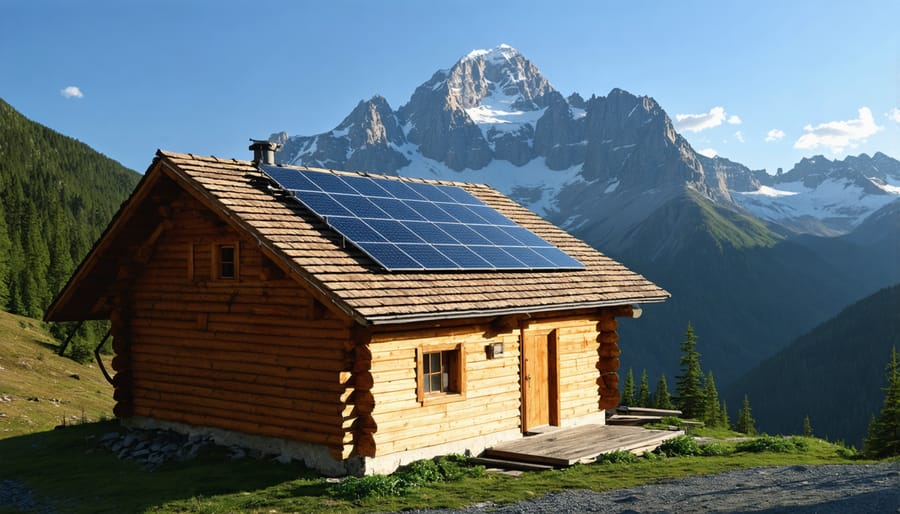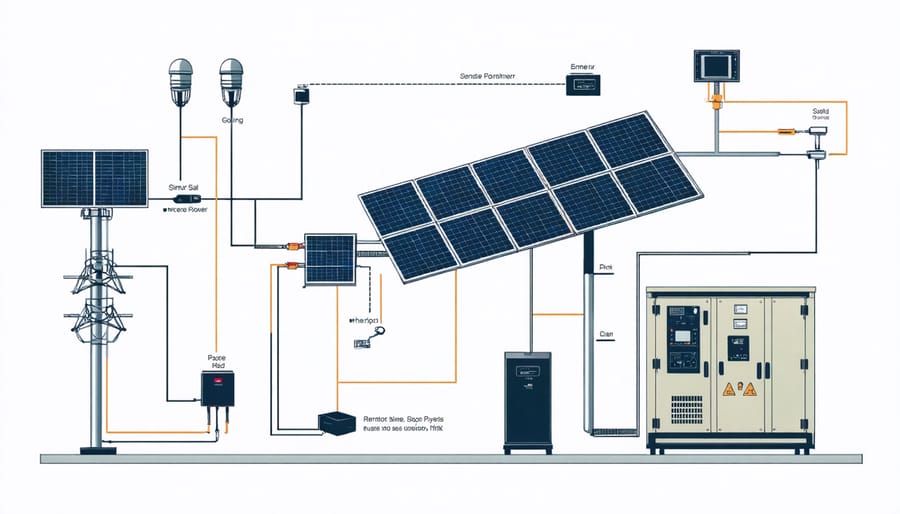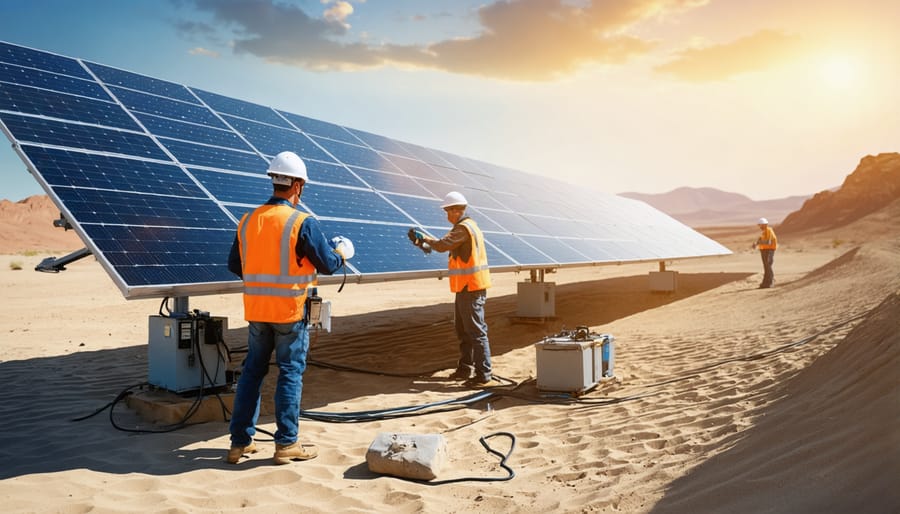Solar Power That Works Anywhere: Your Complete Remote Location Energy Solution

Solar power revolutionizes life in remote locations, transforming energy-scarce regions into self-sustaining environments through advanced renewable technology. Planning an off-grid solar installation delivers reliable power where traditional infrastructure fails, from mountain cabins to isolated research stations across Europe’s diverse landscapes.
Modern solar solutions overcome geographical challenges through innovative storage systems, smart monitoring platforms, and modular designs that adapt to extreme conditions. These systems now achieve up to 25% higher efficiency than a decade ago, making them increasingly viable for remote applications where every watt counts.
Remote solar installations particularly shine in European contexts, where varying seasonal daylight patterns and diverse weather conditions demand sophisticated engineering solutions. From the Arctic Circle to Mediterranean islands, tailored solar configurations provide sustainable power while reducing dependency on diesel generators and costly fuel transportation.
This sustainable approach not only ensures energy independence but also preserves pristine environments, supporting everything from telecommunications infrastructure to agricultural operations in locations previously considered too remote for reliable power access.

Why Solar Power Excels in Remote Locations
Independence from Traditional Infrastructure
Solar power systems in remote locations offer true independence from conventional power infrastructure, providing a reliable energy solution where traditional grid connections are impractical or impossible. These autonomous systems generate, store, and distribute electricity without requiring connection to municipal power lines or regional electrical networks.
The core components work together seamlessly to ensure continuous power supply. Solar panels capture sunlight during daylight hours, converting it into electricity. This energy is then stored in advanced battery systems, which act as a reservoir for use during nighttime or periods of limited sunlight. Charge controllers and inverters manage the power flow, ensuring optimal system performance and converting stored energy into usable household current.
This independence brings practical advantages beyond mere self-sufficiency. Remote solar installations eliminate the substantial costs of connecting to distant power lines, which can often exceed €30,000 per kilometer in rural European regions. Additionally, users avoid recurring utility bills and remain unaffected by grid-related issues such as widespread power outages or maintenance disruptions, ensuring consistent power availability in even the most isolated locations.
Cost-Effective Long-Term Operation
When comparing long-term operational costs, solar power systems demonstrate significant financial advantages over traditional power solutions in remote locations. Initial installation costs are offset by minimal maintenance requirements and zero fuel expenses, resulting in substantial savings over time. Studies across European remote installations show that solar systems typically achieve return on investment within 4-7 years, depending on location and energy consumption patterns.
In contrast, diesel generators require continuous fuel supply, regular maintenance, and frequent part replacements, leading to escalating operational costs. Grid extension to remote locations can cost between €30,000 and €50,000 per kilometer, making it prohibitively expensive for most applications. Solar solutions eliminate these ongoing expenses while providing reliable power for 25+ years with only periodic panel cleaning and occasional inverter maintenance.
The economic advantage becomes even more apparent when considering rising fuel costs and environmental regulations. Modern solar systems with smart monitoring capabilities further reduce operational costs by optimizing energy production and consumption patterns, making them the most cost-effective choice for remote power generation in the long run.

Essential Components for Remote Solar Systems
High-Efficiency Solar Panels
For remote installations, high-efficiency monocrystalline solar panels are the preferred choice, offering superior performance in limited space conditions. These panels typically achieve efficiency rates of 20-23%, significantly higher than conventional alternatives. This enhanced efficiency means fewer panels are needed to meet power requirements, reducing both installation complexity and transportation costs to remote locations.
Premium bifacial solar panels are particularly valuable for remote applications, as they can capture reflected light from both sides, increasing overall energy yield by up to 30% in optimal conditions. This dual-sided capability is especially beneficial in snow-covered regions or areas with highly reflective surfaces.
Temperature-resistant panels with advanced cell technology are crucial for extreme remote environments. Modern n-type panels demonstrate superior performance in high temperatures and maintain better efficiency in low-light conditions, making them ideal for varied European climates.
When selecting panels for remote installations, durability features such as reinforced frames and robust glass coating are essential considerations, as maintenance visits may be infrequent and challenging to arrange.
Advanced Battery Storage Solutions
Modern battery storage solutions are the cornerstone of reliable solar power systems in remote locations. The latest lithium-ion technologies offer exceptional performance, with energy densities up to four times higher than traditional lead-acid batteries and significantly longer lifespans of 10-15 years.
When planning battery capacity for remote installations, we recommend calculating daily energy consumption and incorporating a 2-3 day autonomy buffer. This ensures continuous power supply during periods of limited sunlight or maintenance. For European climates, seasonal variations must be carefully considered, with winter months typically requiring larger storage capacity.
Modern battery management systems (BMS) optimize charging cycles and protect against over-discharge, significantly extending battery life. Smart monitoring capabilities allow remote supervision of battery health and performance through mobile applications or web interfaces, particularly valuable for isolated installations.
Temperature-controlled housing is essential in remote European locations, as battery performance can decrease by up to 50% in extreme cold. Professional installers typically incorporate thermal management systems to maintain optimal operating conditions between 15-25°C.
For enhanced reliability, many installations now implement hybrid storage systems, combining different battery technologies to optimize performance and cost-effectiveness. This might include a combination of lithium-ion batteries for daily cycling and flow batteries for long-term storage, ensuring maximum system efficiency and longevity.
Robust Inverters and Controllers
In remote solar installations, the quality of power management systems is paramount for ensuring reliable operation. Industrial-grade inverters and charge controllers form the backbone of these systems, converting DC power from solar panels into usable AC electricity while maintaining optimal battery health. Modern inverters feature advanced monitoring capabilities, allowing remote diagnostics and performance tracking through satellite or cellular connections.
For European installations, it’s essential to select equipment that meets IEC standards and carries CE certification. Look for inverters with high IP ratings (minimum IP65) to withstand harsh weather conditions and temperature variations. Smart controllers with MPPT (Maximum Power Point Tracking) technology optimize energy harvest, while built-in protection features guard against voltage fluctuations, overcharging, and system faults.
The latest generation of solar controllers includes self-learning algorithms that adapt to usage patterns and weather conditions, maximizing system efficiency while extending battery life. Many units now offer multiple communication protocols, enabling seamless integration with energy management platforms and remote monitoring solutions.
Planning Your Remote Solar Installation
Site Assessment and System Sizing
A thorough site assessment is crucial for designing an effective solar power system in remote locations. Begin by evaluating your site’s solar potential through a comprehensive analysis of daily sun hours, seasonal variations, and potential shading obstacles. European locations typically experience significant seasonal changes in daylight hours, making this assessment particularly important for system efficiency.
To determine your power requirements, create a detailed inventory of all electrical devices and their daily usage patterns. Calculate both peak demand and average daily consumption in kilowatt-hours (kWh). Remember to account for future needs and seasonal variations in power usage. For remote locations, it’s prudent to add a 20-30% buffer to these calculations to ensure system reliability.
The physical characteristics of your installation site also play a vital role. Consider factors such as available space for solar panels, roof orientation and angle (if applicable), soil conditions for ground-mounted systems, and distance from main structures to battery storage areas. Local weather patterns, including snow loads, wind exposure, and temperature extremes, will influence equipment selection and mounting requirements.
Additionally, check local regulations and permit requirements for solar installations in your area. Many European regions have specific guidelines for off-grid systems, particularly in protected landscapes or historic areas. Professional assessment services can help navigate these requirements while ensuring optimal system sizing for your specific needs.
Weather Resilience and Maintenance
In remote locations, solar power systems face diverse weather challenges that require robust maintenance strategies and resilient design. The key to ensuring system reliability lies in implementing comprehensive weather protection measures and regular maintenance protocols.
For European installations, weather-resistant components are essential. High-quality solar panels should feature reinforced glass surfaces and durable frames that can withstand heavy snow loads, intense winds, and potential hail impact. Systems in coastal areas require additional corrosion protection due to salt exposure, while mountainous regions need enhanced structural support for extreme temperature variations.
Preventive maintenance plays a crucial role in system longevity. Regular inspections should focus on checking panel surfaces for debris, examining mounting structures for stability, and ensuring all electrical connections remain secure and properly insulated. Remote monitoring systems can provide real-time performance data and early warning signs of potential issues, enabling prompt intervention before problems escalate.
Snow management solutions, such as elevated mounting angles and specialised coating technologies, help maintain system efficiency during winter months. For regions prone to storms, automated shutdown systems protect equipment during severe weather events, while lightning protection systems safeguard sensitive electronic components.
Professional maintenance schedules should adapt to local climate patterns, with more frequent inspections during challenging seasons. Keeping detailed maintenance records and establishing emergency response protocols ensures quick system recovery after extreme weather events, minimising downtime and maintaining consistent power supply.
Professional Support and Installation
Professional expertise is crucial when implementing solar power systems in remote locations, as these installations often present unique challenges that require specialized knowledge and experience. A qualified solar installation team brings valuable insights into system design, component selection, and installation techniques specifically adapted for remote environments.
Expert installers conduct thorough site assessments, evaluating factors such as terrain characteristics, local weather patterns, and potential obstacles that might affect system performance. They ensure compliance with regional regulations and safety standards while optimizing the system’s layout for maximum efficiency and minimal environmental impact.
Installation teams also provide essential support services, including system commissioning, performance testing, and comprehensive documentation. This professional approach helps prevent common installation errors that could lead to reduced efficiency or system failures – particularly critical in remote locations where repairs can be complex and costly.
Post-installation support is equally important, with many providers offering remote monitoring solutions, scheduled maintenance visits, and emergency repair services. These ongoing support services help maintain system reliability and optimal performance throughout the installation’s lifetime. Professional installers can also train local personnel in basic maintenance procedures, enabling quicker response times for minor issues.
For remote European installations, working with certified professionals who understand local climate conditions and regulatory requirements is particularly beneficial. They can ensure your system is properly winterized, storm-protected, and fully compliant with EU energy standards.

Real-World Applications and Success Stories
Across Europe, successful remote solar installations are transforming previously energy-starved locations into self-sufficient communities. In the Swiss Alps, the Monte Rosa Hut stands as a testament to innovative solar engineering, powering a research station and tourist accommodation at 2,883 meters above sea level. The installation combines 85m² of solar panels with advanced battery storage, providing year-round power despite challenging weather conditions.
The Greek island of Tilos demonstrates another remarkable success story, becoming the first Mediterranean island to run almost entirely on solar and wind energy. The solar component powers 400 households and supports the island’s vital tourism industry, proving that remote locations can achieve energy independence through smart solar solutions.
In northern Norway, the village of Finnmark showcases how solar power adapts to extreme conditions. Despite long winter darkness, their hybrid solar system, combined with storage solutions, provides reliable power during the summer months when the sun never sets, effectively balancing the seasonal variations.
Spain’s Sierra Nevada mountains host several notable installations, including a remote research facility that operates solely on solar power. The system maintains critical scientific equipment and communications infrastructure while withstanding harsh mountain conditions throughout the year.
These success stories share common elements: careful system sizing, robust storage solutions, and professional maintenance protocols. They demonstrate how modern solar technology, when properly implemented, can provide reliable power in Europe’s most challenging locations. The projects also highlight the importance of customized solutions that account for specific geographical and climatic conditions, serving as blueprints for future installations across the continent.
Solar power solutions have proven to be a game-changing technology for remote locations across Europe, offering reliable, sustainable, and cost-effective energy independence. By harnessing the sun’s power, remote properties can overcome grid connection challenges while contributing to environmental preservation. The combination of advanced battery storage systems, efficient solar panels, and smart energy management tools makes modern solar installations more accessible and practical than ever before. Whether you’re powering a remote holiday home in the Alps, an isolated agricultural facility, or a telecommunications station, solar energy provides a robust and future-proof solution. We encourage you to explore the possibilities of solar power for your remote location, considering both the immediate benefits of energy independence and the long-term advantages of sustainable power generation. With proper planning and professional support, your journey to solar-powered self-sufficiency can be both rewarding and transformative.
Leave a Reply